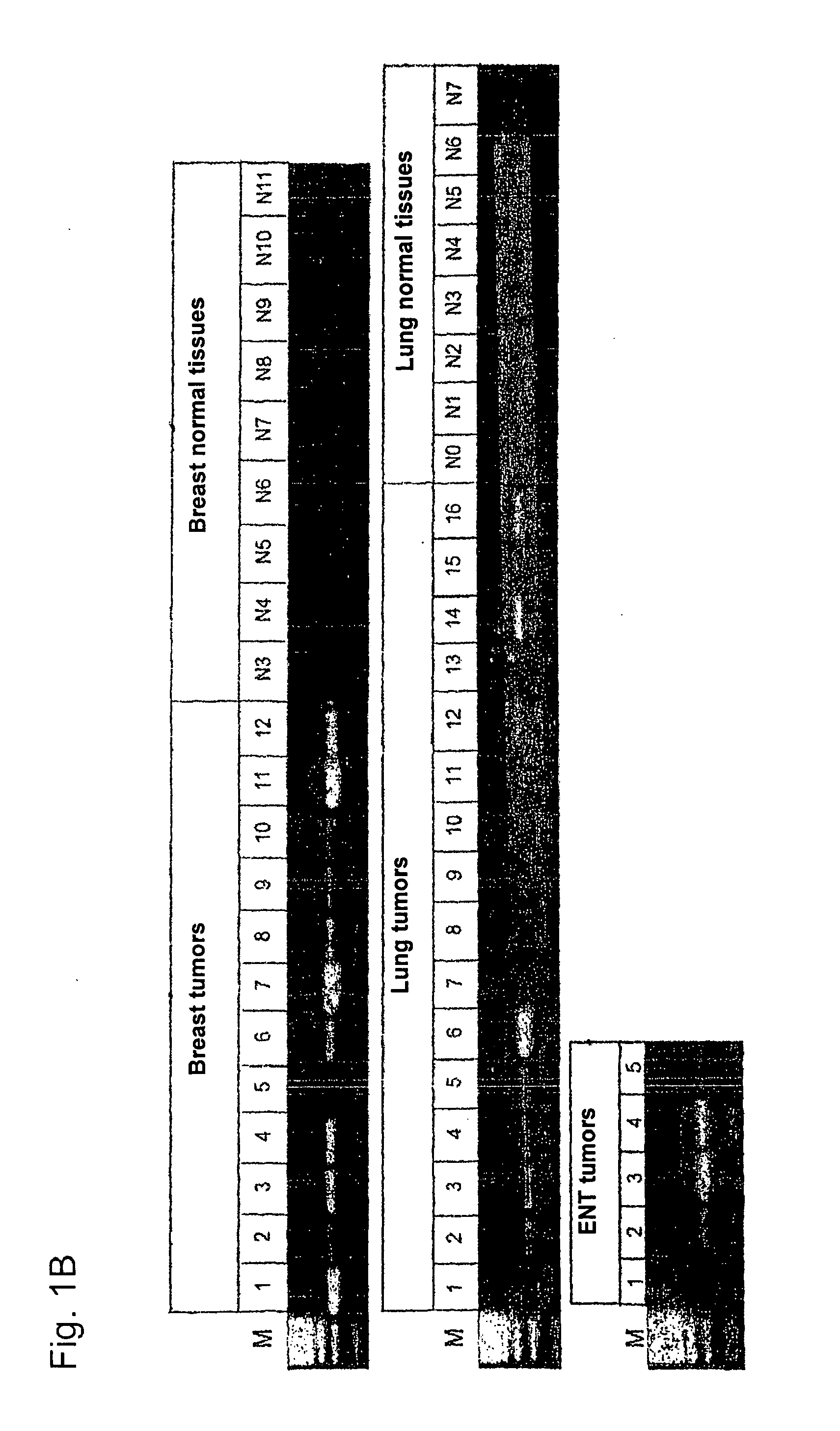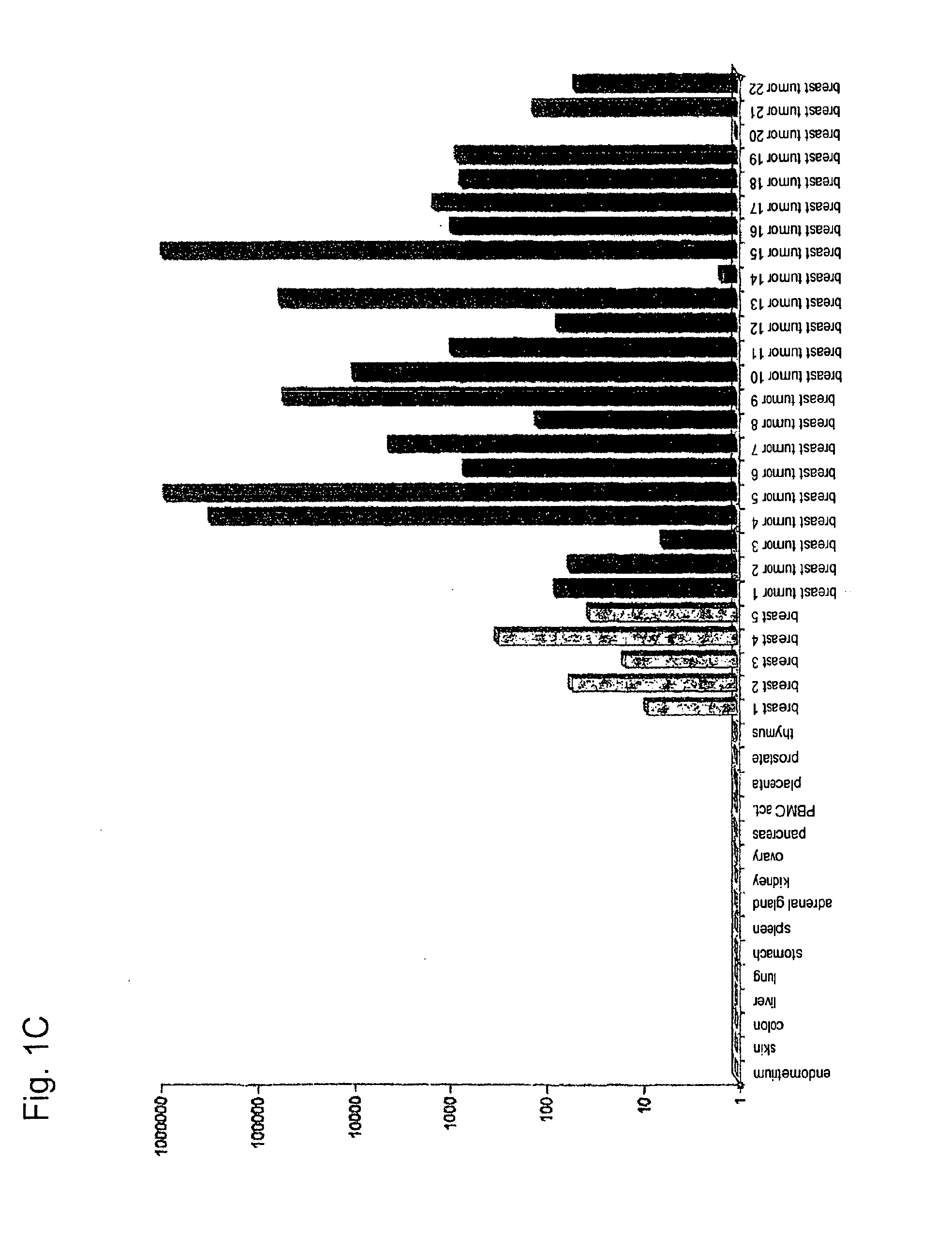Identification of Surface-Associated Antigens for Tumor Diagnosis and Therapy
a technology of surface-associated antigens and tumors, which is applied in the direction of peptide/protein ingredients, dna/rna fragmentation, depsipeptides, etc., can solve the problems of unproven and unproven tumor-associated antigens that have not yet been used in patient studies, and cannot be ruled out that proteins evoking spontaneous immune responses are wrong target structures, etc., to improve the course of the diseas
- Summary
- Abstract
- Description
- Claims
- Application Information
AI Technical Summary
Benefits of technology
Problems solved by technology
Method used
Image
Examples
example 1
Identification of the Hypothetical Protein FLJ31461 as Diagnostic and Therapeutic Cancer Target
[0282]Using gene prediction programs, FLJ31461 (SEQ ID NO: 1) filed under the gene bank accession number NM—152454 was determined as putative functionally not previously characterised gene on chromosome 15 (15q25.3). Two possible open reading frames result from the sequence deposited with the gene bank. The first reading frame encodes a protein with a length of 136 amino acids. The gene product (SEQ ID NO: 2) which was deposited in the RefSeq data bank of the NCBI under number NP—689667, accordingly has a calculated molecular weight of about 15 kDa. The second reading frame encodes a protein with a length of 100 amino acids (nucleotide sequence: SEQ ID NO: 69; amino acid sequence: SEQ ID NO: 70).
[0283]In sequence analyses of the gene FLJ31461 cloned by us, we were surprised to find the insertion of a nucleotide in the coding region in comparison to the sequences deposited in the databases....
example 2
Identification of DSG4 (Desmoglein 4) as Diagnostic and Therapeutic Cancer Target
[0293]Gene DSG4 (desmoglein 4; SEQ ID NO: 75) with its translation product (SEQ ID NO: 76) is a member of the desmosomal cadherin-family. The gene consists of 16 exons and is located on chromosome 18 (18q12). The derived amino acid sequence encodes a precursor protein with a length of 1040 amino acids. The processed protein (N-terminally truncated by 49 amino acids) has a length of 991 amino acids and without modifications a molecular weight of about 108 kDa. It must be assumed that DSG4 is a glycosylised type 1 cell surface protein, just like other desmogleins. DSG4 was able to be detected as constituent of desmosomes (Kljuic et al. 2003. Cell 113: 249-260). Desmosomes are complex intercellular connections, which provide epithelial tissues (such as the epidermis) with mechanical stability. Auto-antibodies against other members of the desmoglein-family appear to contribute to the loss of cell-cell-conta...
example 3
Identification of DSG3 (Desmoglein3) as Diagnostic and Therapeutic Cancer Target
[0305]The gene DSG3 (desmoglein3; SEQ ID NO: 3) and its translation product (SEQ ID NO: 4) is a member of the desmosomal cadherin-family, which is published at the NCBI under accession number NM—001944 (nucleotide sequence) or NP—001935 (protein sequence). The gene consists of 15 exons and is located on chromosome 18 (18q12.1-q12.2). The derived amino acid sequence encodes a protein with 999 amino acids and a hypothetical size of about 130 kDa. DSG3 is a glycosylated type 1 cell surface protein and is able to be detected in desmosomes (Silos et al. J. Biol. Chem. 271: 17504-17511, 1996). Desmosomes are complex intracellular connections connecting the keratin filaments of adjacent cells in order to provide epithelial tissues (such as for example the epidermis) with mechanical stability. The desmosomal cadherines desmoglein and desmocollin are calcium-dependent adhesion molecules. Auto-antibodies against d...
PUM
| Property | Measurement | Unit |
|---|---|---|
| temperatures | aaaaa | aaaaa |
| total volume | aaaaa | aaaaa |
| temperature | aaaaa | aaaaa |
Abstract
Description
Claims
Application Information
 Login to View More
Login to View More - R&D
- Intellectual Property
- Life Sciences
- Materials
- Tech Scout
- Unparalleled Data Quality
- Higher Quality Content
- 60% Fewer Hallucinations
Browse by: Latest US Patents, China's latest patents, Technical Efficacy Thesaurus, Application Domain, Technology Topic, Popular Technical Reports.
© 2025 PatSnap. All rights reserved.Legal|Privacy policy|Modern Slavery Act Transparency Statement|Sitemap|About US| Contact US: help@patsnap.com



